Learning how to build a backyard football field is one way to surprise your kids with an activity they can enjoy.
If you’re looking for kid-friendly activities that can max out all of your child’s energy, football is a great sport to go for.
Not only will it help them build stamina but also an opportunity to keep them busy playing while you do your piled-up chores.
In this post, we’ll help you build a mini version of a football field that both adults and kids can enjoy.
It doesn’t matter if you have a small space, as long as you can run around and block the goal, that’s good to go!
What Type Of Football Court Do You Want To Build?
First, you have to decide about the type of football field that you want to achieve. Are you aiming to build a halfcourt or you have enough space for a full-court football field?
Either way, we think you can gain more perspective by checking out the standard sizes needed for a whole football field.
Standard Size of a Football Field
The standard size of a football field is 360 feet (110 meters) in length and 160 feet (49 meters) in width. There’s a 10-yard gap between the end line and the goal line. Since we’re trying to fit the football field in your backyard, we’ll use the ratio of 16:9 feet:
Recommended football field size based on backyard size:
- Small backyard: 16 ft. long x 9 ft. wide
- Mid-sized backyard: 32 ft. long x 18 ft. wide
- Large backyard: 64 ft. long x 36 ft. wide
The size doesn’t matter if you’re just aiming for the look of the field. However, if adults in your family want to play football too, then the measurements matter to have a fair game.
Parts of a Football Field
Now, let’s head on to the details of your football field. Completing the parts of the football field makes your game feel like you’re playing like an NFL star.
Here are the parts of the football field and what they stand for in the NFL rule book:
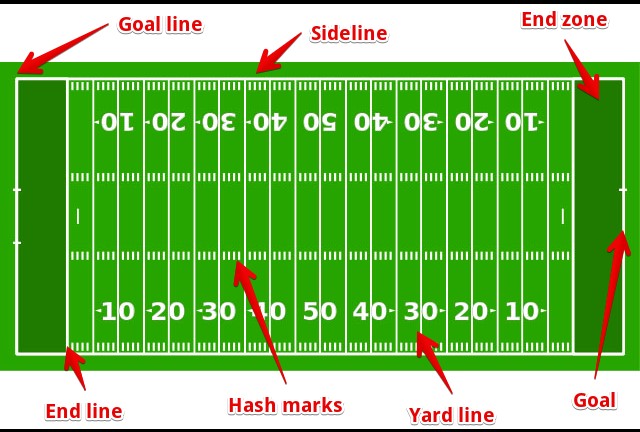
- End zone: refers to the 30 feet (9.1m) gap between the end line and the goal line. It’s where you paint your team logo and indicates where your goal is located.
- Hash marks: refer to the two horizontal lines that indicate the boundaries between two teams during a scrimmage.
- Goal: pertains to the net where you should kick the ball to score against your opponent.
- Yard line: refers to the lines spaced at a 10-yard interval that indicates the yard number from the scrimmage to the end zone. The defense of a team in the yard lines closer to the end zone means it belongs to them or what’s known as the 25-yard line.
- Sideline: pertains to the lines that reflect the length of the football field.
- Goal-line: refers to the line that serves as the basis if it’s a goal or not.
How To Build a Backyard Football Field
Since you’re building the football field on your property, your rules will prevail. It’s up to you if you want to mark all the parts of the field or you want to modify them based on your kid’s preferences.
Materials
Before you begin, here are the materials that you should prepare:
- Tape measure – helps measure the field to mark accurate field size and markings
- String – used as a guide in painting a straight on the grass
- Turf paint (white) – used to mark the field
- Football goal – either bought-online or handcrafted goal
- Artificial turf – a good option if you want to build a permanent backyard football field
- Shovel – used to level the football field
A Step-by-Step Guide
Here are the steps to build your backyard football field:
Step 1: Level The Playing Field
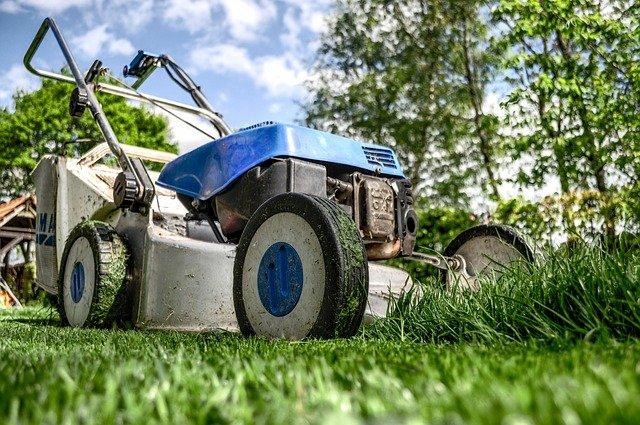
You might have heard this phrase a lot in movies but this is something that should be done to make sure you’re playing a fair game. Look out for holes and uneven parts of the field.
It should be flat and no stones that may cause someone to fall on their knees. Use the shovel to make sure the field is flat enough for you to play on it. You may practice running through it and see if it won’t cause any accidents.
Step 2: Apply Artificial Grass or Trim Your Lawn Grass
If your backyard has been maintained with luscious grass then the only thing you need to do is to mow your lawn. The real grass is a good option if the football field is temporary.
If not, then you may want to consider buying artificial grass to keep your football field low maintenance and ready for the long haul.
Pro tip: While growing the grass on your backyard football field is cheaper, an artificial lawn can withstand different weather conditions and doesn’t have to be maintained from time to time.
Step 3: Measure Your Football Field
Now that the lawn is ready, you may start marking the four corners of your football field.
You may refer to our recommended field sizes above or you may do any size modifications that you prefer. Use the tape measure to get the accurate sizes and mark each corner with a stone or a flag.
Step 4: Paint The Sidelines
Using a string as a guide, paint the sidelines with the turf paint slowly and make sure that you’re drawing a straight line. Don’t forget to mark the end zones as you paint the whole perimeter of the field.
Step 5: Mark The Endzones:
Measure the endzone by adding 30 feet from the end line to the goal line for standard-sized football fields. For a small-scale field(16×9), end zones should be 2 feet starting from the end line to the goal line.
Step 6: Draw The Yard Lines
Here’s the tricky part. The yard lines are measured by 10 yards apart.
Since we’re building the mini version, you need to get the actual size of the playing field between the two end lines and divide it by 12. Continue to use the string as a guide in marking your yard lines.
Step 7: Place The Hash Marks:
The hash lines are parallel to your sidelines but end at the end line. The distance between the sidelines and the hash marks is 70 feet for the standard football field. To get the distance, multiply your field’s width by 0.4375. For example:
- Small backyard: 16 x 9 field
- Distance between hash marks and sidelines 3.9 feet = 9 feet * 0.4375
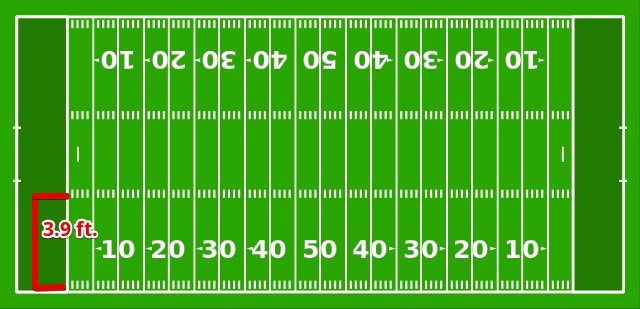
Step 8: Place Your Goals on Both Ends
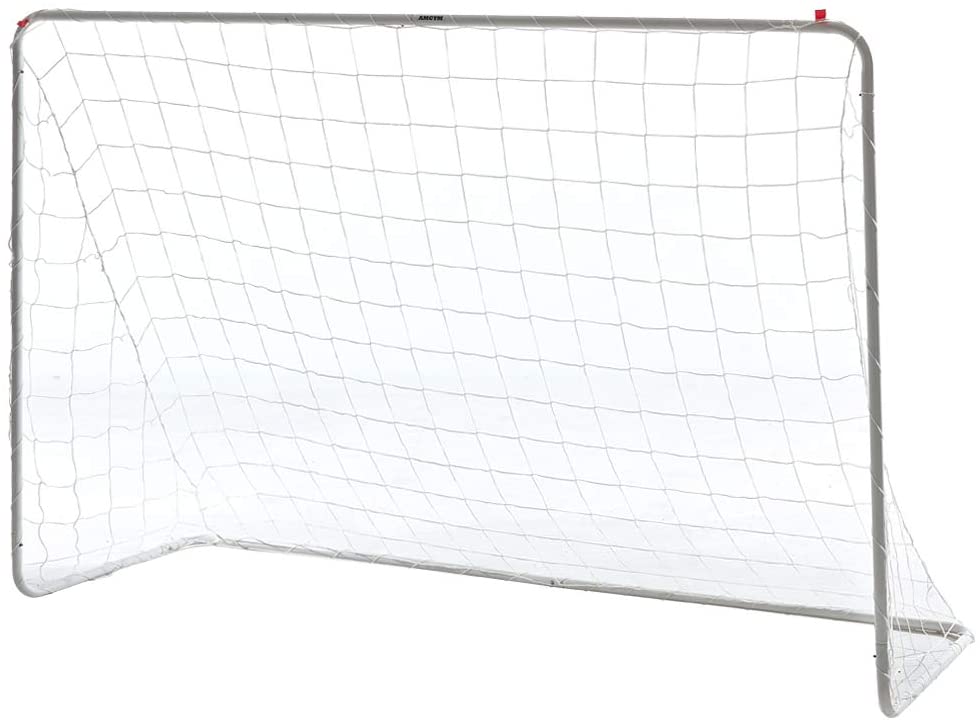
To finalize the standard look of a football field, you may now place the goals at the center of both ends of the field.
There available ready-made football goals on Amazon. There are different heights for all ages, so make sure to check that out before purchasing.
Step 9: Decorate Your End zones

Here’s the fun part. You may design your end zones based on your favorite NFL team using turf paints. Talk about creativity!
Here are some of the logos that you may draw on the grass.
Step 10: Test out Your Football Field and Start Playing with Your Friends and Family
There’s no other way to know if you did the right job than to test the field yourself. Enjoy your first game and show them your incredible kick!
How To Build a Half-Backyard Football Field
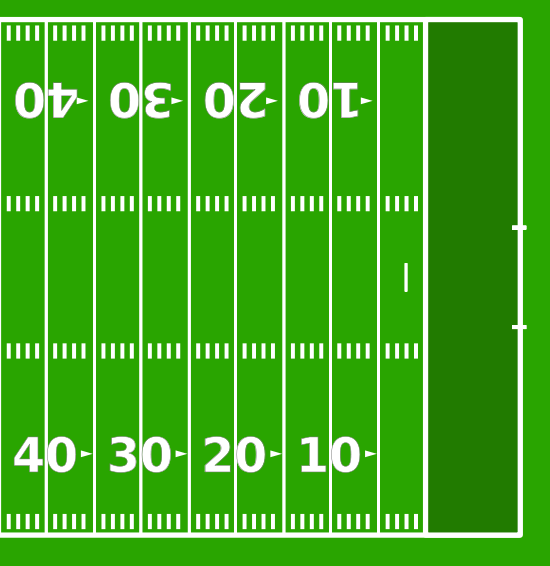
There are instances where a backyard is not suitable to have a full-scale football field. You may draw it like a real one but the limited space may snatch the fun of running around. So, you can make a half football field instead.
You’ll use the same materials mentioned above and the only thing we have to adjust is the measurement.
A Step-by-Step Guide
Here’s are the steps on how to build a half football field:
Step 1: Level The Playing Field:
Keep stones and other obstacles away from your field. You should also check for inclines and holes on the ground to avoid any accidents during the game.
Step 2: Measure The Area
Since we’re following the 16:9 ratio, the half field will have the following dimensions based on the size of your backyard:
Field size:
- Small backyard: 8 ft. long x 4.5 ft. wide
- Mid-sized backyard: 16 ft. long x 9 ft. wide
- Large backyard: 32 ft. long x 18 ft. wide
Step 3: Assign The End Zone
Choose the side against the fence for your end zone. This will help you free from hesitations in kicking your goal shot since you won’t be breaking any windows or windshields. The measure of your end zone are as follows:
End zone size:
- Small backyard: 2 ft. long x 4.5 ft. wide
- Mid-sized backyard: 4 ft. long x 9 ft. wide
- Large backyard: 8 ft. long x 18 ft. wide
Step 4: Mark The Yard Lines
The field of play will be the space left after you marked the end zones. Here are the recommended measurements between the 6-yard lines:
Playing field size:
- Small backyard: 1 ft.
- Mid-sized backyard: 2 ft.
- Large backyard: 4 ft.
Step 5: Paint The Hash Marks
There will be no adjustments on the hash marks since it’s measured against the width of your football field. To get the distance between the sidelines and your hash lines, multiply your field’s width by 0.4375.
Recommended distance from sidelines:
- Small backyard: 1.96 ft.
- Mid-sized backyard: 3.93 ft.
- Large backyard: 7.87 ft.
Step 6: Place Your Goal:
Your goal should be placed in the middle of the goal line.
Step 7: Test Your Football Field
Even with a half football field, you’ll surely enjoy the challenge of defending your goals and practicing your kicks.
4 Helpful Tips in Building Your Backyard Football Field
If you’ve been a DIY fan from day one, you will surely try to modify some of our steps in this post.
Regardless of the preferences you want for your football field, here are some tips, you should consider before making any rash decision:
Tip 1: The bigger the field, the more expensive it can be especially if you’re going to use artificial grass. However, the amount of labor required in growing the grass is also at the same rate.
- Artificial grass = $5 per squarefoot
- Grass seeds/ sod = $0.05 per squarefoot
Nevertheless, it’s still up to you to choose the effort you’re willing to give for your backyard football field.
Tip 2: Not all types of grass can tolerate heavy foot traffic. The best types of grass for a football field:
- Sod
- Bermuda grass
- Ryegrass
- Kentucky bluegrass
Tip 3: Place the goals against a fence to avoid breaking windows and hitting the cars of your neighbors.
Tip 4: The charm of football fields lies on its lawn. If you’re going to go for a grass lawn, here are some lawn care tips:
- Use a lawn liquid fertilizer to support the growth of your grass and keep it away from damaging insects and fungal diseases.
- Practice dethatching your lawn to prevent it from getting muddy.
- Allow the sun to shine over the lawn.
- Remove the grass cuttings after mowing the lawn to prevent them from building up. If the old leaves pile up, it covers the soil and won’t allow the soil to get the optimal oxygen that it needs.
Final Thoughts
Despite the current situation of our world today, the quarantine has given us the time to re-evaluate the things that we have including the spaces we have at home.
Building a backyard football field is a great way to maximize your property and make it a safe place for your kids amid the pandemic.
Having your own football field also helps your kids hone their athletic skills and might spark their interest to pursue it as a career when they grow up. We hope that this post has helped you build your own football field with ease.
If you find this post helpful to your DIY football field, share it with your friends and family. Also, let us know who won the first game using your backyard football field.

Hello there. This was an awesome, helpful post. Thanks for all the great pointers. I would love to construct a football field on our property. We have the room (over 11 acres), although a good portionof it is woods. Do you have a suggestion of which artificial turf is best? Is it easy to take up? I would like to lay it on our drain field.
Artificial turf is a good cover to your drain field as long as you don’t add any fill underneath. You can easily flip the turf over when you want to move your field or fix something on your drain field. If you want quality turf that can withstand the outdoor elements, MEGAGRASS Premium Synthetic – Turf is a good option. For large scale football field you can have the turf from this brand (link). Some artificial turfs are really thin which may not be durable enough to withstand the scorching sun or rain downpours. Good luck on your new football field project! Nothing beats playing near the woods – no hesitations to throw that ball!